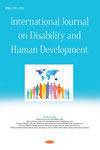Research on articulation problems of Turkish children who have Down syndrome at age 3 to 12
International Journal on Disability and Human Development
Pub Date : 2017-01-26
DOI:10.1515/ijdhd-2016-0017
引用次数: 1
Abstract
Abstract Background: Articulation is a process that allows air to pass through vocal cords and then form words and syllables using the tongue, teeth, mentum and palatine tonsils. A person who has pronunciation problems produces, syllables or words inaccurately so; the auditoria have got difficulty to understand what did say, such that the listener has difficulty in understanding what is being said. Due to being genetically different the Down syndrome individual has difficulty with speech due to structural defects in the mouth and problems with the mouth-tongue muscles. Aim: Here the determination of the articulation (pronunciation) problems and the probable causes of the determined problems have been studied. Methods: This study involved children without hearing loss problems; 17 females and 23 males who have Down syndrome and were ages between 3 and 12 years. The Ankara articulation test (AAT) was applied to the individuals. The articulation (pronunciation) ages have been determined according to the ATT. By the detailed assessment of the ATT, it was determined which voices were uttered correctly or not. Through a family interview survey, the information that affected the development of the Down syndrome child’s speech and academic development was obtained. Through a patient identification survey, the education and health information that may effect the speech development were obtained. Through an oral motor assessment survey, the information regarding the competence of oral motor skills that may effect articulation problems were collected. The data were analyzed. Using a family survey, child identification survey and an oral motor assessment survey the correlation between articulation age and articulation defects were viewed. Results: It has been detected that the articulation age of Down syndrome children between 3 and 12 years of age are quite a bit lower when compared to the chronological age according to the ATT. Moreover, in terms of results from the ATT, children with Down syndrome whose cronological age is 8 years 7 months have a 3 year 5 months’ articulation age according to the ATT. They have some difficulties with Turkish vowels such as (/a/, /e/, /ı/, /i/). Also they have some difficulties with consonants such as (/r/, /j/, /z/, /ş/, /z/, /l/, /s/, /n/). Articulation defects at various levels have been detected for all Down syndrome children. Articulation (pronunciation) problems were encountered less in children from highly educated and more concerned families. It has been shown that articulation (pronunciation) problems are less children who receive early treatment, therapy and education services. Conclusion: Significant correlation between the level of articulation usage by individuals and frequency of the articulation problem were detected. For this reason, attaching importance to oral motor studies are considered. Raising parental awareness is required on prenatal diagnosis of Down syndrome. By treating the problems of the speech organs at an early age and including the children who have Down syndrome into the early education programs around 0–3 years and accurate intervention during critical periods, the articulation problems can be reduced. Using a wider age range and having more participants, it is considered that more efficient results may be obtained.土耳其3至12岁唐氏综合征儿童发音问题的研究
摘要背景:发音是一个让空气通过声带,然后利用舌头、牙齿、门蒂和腭扁桃体形成单词和音节的过程。一个有发音问题的人产生的音节或单词不准确;听众很难理解他们说了什么,所以听众很难听懂他们在说什么。由于基因不同,唐氏综合症患者由于口腔结构缺陷和口舌肌肉问题而难以说话。目的:本文研究了发音问题的确定以及确定问题的可能原因。方法:本研究涉及没有听力损失问题的儿童;17名女性和23名男性患有唐氏综合症,年龄在3至12岁之间。安卡拉发音测试(AAT)被应用于个体。发音(发音)年龄是根据ATT确定的。通过对ATT的详细评估,可以确定哪些声音发音正确与否。通过家庭访谈调查,获得了影响唐氏综合症儿童言语和学业发展的信息。通过患者识别调查,获得了可能影响言语发展的教育和健康信息。通过口腔运动评估调查,收集了可能影响发音问题的口腔运动技能能力的信息。对数据进行了分析。通过家庭调查、儿童识别调查和口腔运动评估调查,观察了发音年龄与发音缺陷之间的相关性。结果:已经发现,与ATT的实际年龄相比,3至12岁的唐氏综合症儿童的发音年龄要低得多。此外,就ATT的结果而言,根据ATT,年龄为8岁7个月的唐氏综合征儿童的发音岁为3岁5个月。他们对土耳其语元音有一些困难,例如(/a/,/e/,/ı/,/i/)。此外,他们在辅音方面也有一些困难,如(/r/,/j/,/z/,/zs/,/l/,/s/,/n/)。所有唐氏综合症儿童都发现了不同程度的发音缺陷。来自受过高等教育和更关心家庭的儿童较少遇到发音问题。研究表明,接受早期治疗、治疗和教育服务的儿童较少出现发音问题。结论:个体的发音使用水平和发音问题的频率之间存在显著相关性。因此,应重视口腔运动研究。需要提高父母对唐氏综合症产前诊断的认识。通过在早期治疗言语器官的问题,并将患有唐氏综合症的儿童纳入0-3岁左右的早期教育计划,并在关键时期进行准确的干预,可以减少发音问题。使用更宽的年龄范围和更多的参与者,可以获得更有效的结果。
本文章由计算机程序翻译,如有差异,请以英文原文为准。
求助全文
约1分钟内获得全文
求助全文

 求助内容:
求助内容: 应助结果提醒方式:
应助结果提醒方式:


